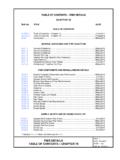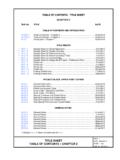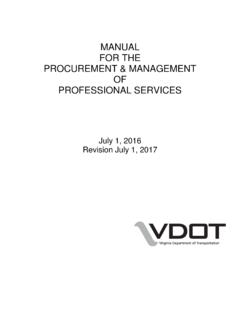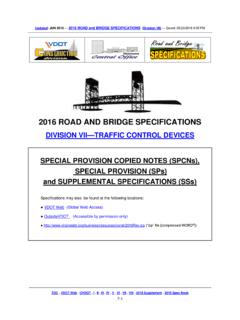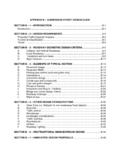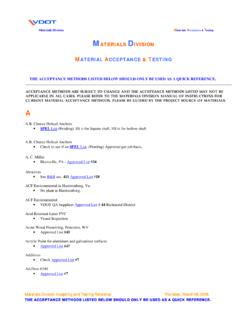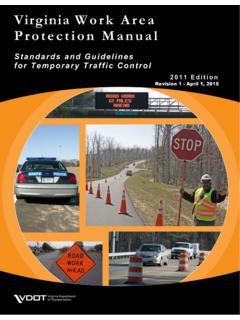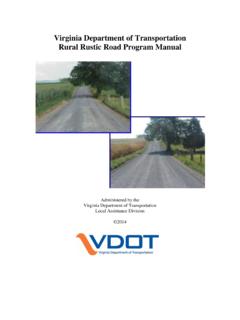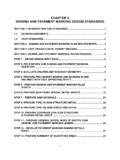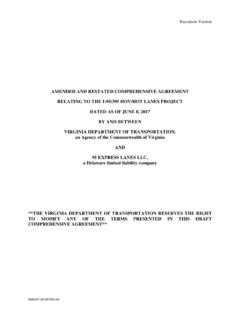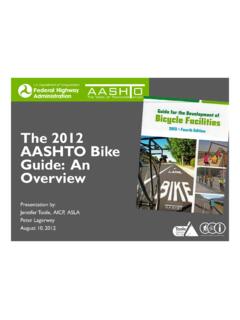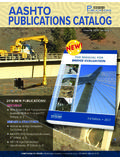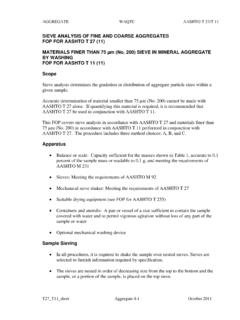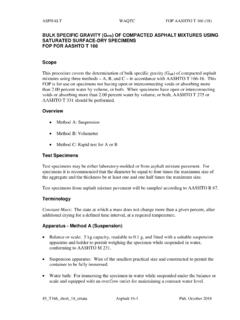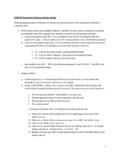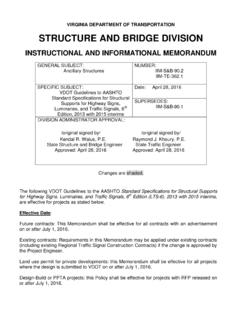Transcription of VIRGINIA DEPARTMENT OF TRANSPORTATION STRUCTURE AND BRIDGE ...
1 VIRGINIA DEPARTMENT OF TRANSPORTATION STRUCTURE AND BRIDGE division INSTRUCTIONAL AND INFORMATIONAL MEMORANDUM GENERAL SUBJECT: VDOT Modifications to the aashto LRFD BRIDGE Design Specifications, 7th Edition, 2014 VDOT Modifications to the aashto LRFD Guide Specifications for the Design of Pedestrian Bridges, 2009 NUMBER: IIM-S& SPECIFIC SUBJECT: Date: August 25, 2015 SUPERSEDES: IIM-S& division ADMINISTRATOR APPROVAL: /original signed/ Kendal R. Walus, State STRUCTURE and BRIDGE Engineer Approved : August 25, 2015 Changes are shaded.
2 The following VDOT Modifications to the aashto LRFD BRIDGE Design Specifications, 7th Edition, 2014, and the VDOT Modifications to the LRFD Guide Specifications for the Design of Pedestrian Bridges, 2009, are effective for projects with an Advertisement date after June 14, 2016. The LRFD specifications are applicable to new construction, total BRIDGE replacement, superstructure replacement, widening projects, etc. Variance from the VDOT Modifications to the specifications shall require a design exception, design waiver or design approval. For complete information on and requirements of design exceptions/waivers/approvals, see Section of Part 1 of the Manual of the STRUCTURE and BRIDGE division .
3 The requirements of Part 2 of the Manual of the STRUCTURE and BRIDGE division shall be adhered to in conjunction with this IIM. Instructional & Informational Memorandum IIM-S& Sheet 2 of 14 aashto LRFD BRIDGE Design Specifications, 7th Edition, 2014 SECTION 1: INTRODUCTION: Load modifiers: Load modifiers specified below shall be used. Each condition shall be compounded when applied. 1. For fracture critical elements, R shall be taken as for service and strength limit states. 2. For permanent vehicular structures which cannot be easily widened (including, but not limited to, trusses, concrete segmental boxes and bridges supported by Straddle Bents or Integral Caps, R shall be taken as for strength limit states.)
4 3. For all post-tensioned concrete superstructures, the superstructure(s) shall be taken as I = for service limit states. And when superstructure is post-tensioned, integral pier substructures (including but not limited to, Integral Straddle Bents, Integral Caps and pier caps) shall be designed using I = for both service and strength limit states. Integral abutments shall be designed for I = 4. When external tendons and/or unbonded internal tendons are used (for superstructure or substructure), elements shall be designed using R = for both service and strength limit states and D = for strength limit states. For other conditions, all load modifiers ( D, I , R and i) shall be for all limit states.
5 Situation 1: Fracture Critical Structures I D R Sub STRUCTURE Service Strength Super STRUCTURE Service Strength Situation 2: Not Easily Widened Structures I D R Sub structureService Super structureService Situation 3: Post-tensioned Superstructures I D R Sub* STRUCTURE Service Strength Super STRUCTURE Service Strength * Only for integral pier substructures Situation 4: Structures with tendons (External or Unbonded internal) I D R Sub structureService Super structureService All Other Structures I D R Sub STRUCTURE Service Super STRUCTURE Service Instructional & Informational Memorandum IIM-S& Sheet 3 of 14 Examples: STRUCTURE Type Condition Limit State I D R i Steel straddle bent with multiple beam/girders Sub Str.
6 1: Yes Service Service = Strength = Strength 2: Yes Service Strength 3: No Service Strength 4: No Service Strength Final Service Super Str. 1: No Service Service = Strength = Strength 2: Yes Service Strength 3: No Service Strength 4: No Service Strength Final Service STRUCTURE Type Condition Limit State I D R i An integral concrete straddle bent with unbonded internal tendons and post- tensioned superstructure Sub Str. 1: No Service Service = Strength = Strength 2: Yes Service Strength 3: Yes Service Strength 4: Yes Service Strength Final Service Super Str.
7 1: No Service Service = Strength = Strength 2: Yes Service Strength 3: Yes Service Strength 4: Yes Service Strength Final Service Instructional & Informational Memorandum IIM-S& Sheet 4 of 14 SECTION 2: GENERAL DESIGN AND LOCATION FEATURES: Deflections: Deflection limits as noted in Article shall be adhered to. Maximum Span Lengths: Maximum span lengths shall be limited by applicability of distribution factors for cross section types as shown in Article Distribution Factor Method for Moment and Shear even when a refined analysis is used. Span-to-Depth Ratios: Span to depth ratios as noted in Article , including Table , shall be used.
8 For variable web depth structures, the maximum ratio between the deeper web depth and the shallower web depth shall be less than or equal to Drainage: See Chapter 22 of Part 2 of the Manual of the STRUCTURE and BRIDGE division for guidance. Gutter flow shall be intercepted at cross slope transitions to prevent flow across the BRIDGE deck. SECTION 3: LOADS AND LOAD FACTORS: Application of Vehicular Live Load: In Article - General, the following shall be added to the list of extreme force effects: The Notional Rating Load (NRL) rating factors shall be computed under conditions required by current VDOT IIM-S&B-86. BRIDGE shall be designed so that the rating factors exceed Substructures need not be checked for NRL.
9 Calculation of Seismic Design Forces: The seismic design forces shall be determined in accordance with the 2015 Interim Revisions in conjunction with the aashto LRFD BRIDGE Design Specifications. Future Wearing Surface: An allowance of 15 psf minimum shall be used. Construction Tolerances/Construction Methods: An allowance of 20 psf carried by the non-composite section of beam/girder span(s) having cast-in-place slabs shall be used. This allowance is sufficient to cover additional loads incurred by the use of stay-in-place metal forms and extra slab thickness caused by construction tolerances. The 20 psf shall be applied to the entire area of the deck not only where stay in place forms are used.
10 An allowance of 10 psf shall be applied where metal stay-in-place forms are not required, for example, prestressed concrete voided slabs, adjacent box beams, etc. which will have cast-in-place concrete slabs or asphalt overlays. Wearing Surface: All concrete deck slabs shall be considered to have a integral wearing surface which shall be included in the loads but not considered as part of the design section. Instructional & Informational Memorandum IIM-S& Sheet 5 of 14 Multiple Presence Factors: When designing superstructure or substructure elements which are not capable of redistribution of load (single columns, hammerhead piers, concrete straddle bents) or are fracture critical (steel straddle bents), the multiple presence factors in Section shall not be taken as less than regardless of the number of lanes loaded on the STRUCTURE for average tributary spans greater than 120 feet.
